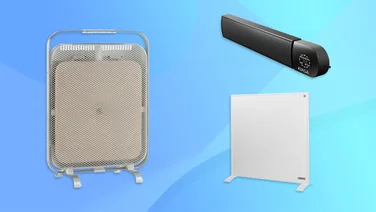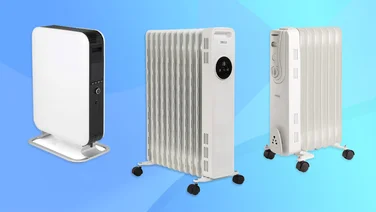To help us provide you with free impartial advice, we may earn a commission if you buy through links on our site. Learn more
- Are oil-filled radiators cheap to run?
- What is an oil-filled radiator and how does it work?
- How much does an oil-filled radiator cost to run?
- Are oil-filled radiators energy efficient?
- What else should I consider when buying an oil-filled radiator?
- Advantages of oil-filled radiators
- Disadvantages of oil-filled radiators

Energy bills always seem to be going up, so finding a cost-effective way to heat your home is important. Could one of the best oil-filled radiators be cheaper than running another type of electric heater?
With more and more of us working from home or hybrid working, higher energy consumption – and its associated cost – has become a common complaint for many people. Add this to the rising prices of gas and electricity, and many people are looking for ways to keep their boilers switched off as much as possible. Along with considering some of the best ways to save energy, it’s also worth thinking about how you heat your home.
Are oil-filled radiators cheap to run?
Oil-filled radiators can be a relatively affordable heating option. As Jon Bonnar, managing director at Cotswold Energy, explains: “In general, oil-filled radiators … continue heating the room long after they’re switched off. This means it will stay warmer for longer … than an electric convection heater … You can
[also]
use them to only heat the room you’re in, to keep costs low. If you use your central heating, you could potentially be wasting energy by heating an unused space.”However, there are other things you should take into consideration before you buy one. Nick Duggan, director of The Radiator Centre, told us: “While oil-filled radiators are generally considered cost-effective to run compared to other electric heaters, the exact cost will depend on factors such as the size of the radiator, the electricity tariff in your area and how you use the heater. It’s also worth noting that, while they may be cheaper to run than some alternatives, they are still electric heaters and will contribute to your overall electricity bill.”
What is an oil-filled radiator and how does it work?
First things first, what actually is an oil-filled radiator? Jon Bonnar enlightened us: “Oil-filled radiators don’t burn the oil as fuel – they work by using electricity to heat the oil inside through an element that sits in the centre of the oil. When this element heats up, warmth is transferred to the oil which then circulates around the appliance and warms the metallic panels.”
“They can be installed on the wall like a standard radiator, or they can be freestanding units which can be moved around the home as needed. The ability to heat just one area makes them so popular. As there’s no fire-hazard element and they’re very quiet, they won’t disturb you and are safer than many other portable heaters.”
READ NEXT: Best electric raditors
How much does an oil-filled radiator cost to run?
Oil-filled radiators can be some of the best electric heaters you can invest in, but how much do they cost to run? Fortunately, Jon is on hand with some sums: “The cost of running an oil-filled radiator depends on a variety of factors, including the type, the size, your providers’ energy prices, the time you use it and where you live. However, electricity is currently being charged at a unit rate of 30.12p/kWh, so you can use this to work out the cost of your heater by dividing the wattage by 1,000 and multiplying it by the current cost of electricity. For example, a 500W oil-filled radiator will cost 15.06p to run each hour under the current rate, while a 2,000W oil-filled radiator will cost you around 60.24p to run per hour.”
There are other things to keep in mind when it comes to working out how much it will cost to run an oil-filled radiator. For example, if you want to heat a larger room with only one radiator, you’ll need to leave the heater on for far longer for it to have a discernible effect. And if your house is poorly insulated, you’ll lose more of the heat you’re paying for, upping the cost further. But the oil inside an oil-filled radiator retains heat very well and will keep emitting warmth even after it’s turned off, which has the potential to save on running costs.
READ NEXT: Best raditor reflectors
Are oil-filled radiators energy efficient?
“As with all electric radiators, oil-filled radiators are 100% efficient at the point of use,” says Jon. “This is because these heaters convert every watt of electricity used into heat and ensure that none is lost along the way. This also means that you’re not paying for wasted energy too.”

So oil-filled radiators are as energy efficient as your home allows – the better your home can retain the heat produced, the less energy you’ll require.
READ MORE: The best ways to keep your house warm
What else should I consider when buying an oil-filled radiator?
There are several things to think about when you’re looking for an oil-filled radiator and evaluating your options. These include:
1. Heating controls
The most basic oil-filled radiators only come with a simple on/off switch, but if you can up your budget a little you’ll be rewarded with extras, such as timers and temperature gauges. We would recommend looking for one with programmable heating controls, as this allows you to create a heating routine that’s designed to work around you and your lifestyle, setting the temperature you want, when you want it and avoiding wasting heat in a room you won’t be using.
2. Size
A larger radiator with a larger surface area (these will be divided into fins) will always be more efficient at generating heat. Since an oil-filled radiator works by pushing thermal fluid into every small part of it, which then warms up the air around it, a larger radiator will be able to warm up more of the surrounding air.
3. Wattage
The larger the room you want to heat, the higher the wattage you’ll need. As a very rough guide, allocate 100 watts for every square metre – a 600W radiator will heat a small 6m2 room, a 1,000W will heat a 10m2 room and a 2,500W will successfully heat a 25m2 room. If you don’t buy a radiator with sufficient wattage, you’ll need to keep it switched on longer to warm your room, costing you far more in the long run.
4. Portability
Buy a portable oil-filled radiator and you’ll be able to take it from room to room. Since this would let you just heat the room you’re in, rather than heating the whole house, this can potentially save a huge amount of money. If you do decide you want a portable radiator, we would recommend choosing one with castor wheels, rather than static feet, to make it much easier to move. A carry handle is also useful, if not downright essential.
5. Location
The best place to put an oil-filled radiator is underneath windows or near doors. This might seem a little counterintuitive but, since an oil-filled radiator works by heating the ambient air around it, if you can get it to warm up the coldest parts of the room, and eliminate any draughts, your room will feel warmer far faster.
6. Stable temperature
The key to keeping costs down is keeping the temperature in your home as stable as possible. If the temperature drops, your oil-filled radiator will have to work harder for longer to warm a room back up again and this will, obviously, cost you more money.
READ NEXT: Best conservatory heaters
Advantages of oil-filled radiators
Probably the biggest advantage of oil-filled radiators is their portability. Having the ability to move the radiator around allows you to position it where it will be most effective in any given room. It also gives you the ability to heat areas of a house that a conventional heater might not reach.
In addition to this, oil-filled radiators are nearly 100% energy efficient as they directly convert electrical energy into heat energy without any noticeable losses. The thermostats, timers and adjustable heating modes all typically consume less than 1% of the heater’s energy requirements.
Disadvantages of oil-filled radiators
Unfortunately, oil-filled radiators do take longer to heat up than other electric convection heaters, meaning you’ll need to allow time for the heater to warm up a room. We would expect it to take around 20-30 minutes to get a room to the optimum temperature. This is where a timer comes in useful, as you can preset the radiator to warm up the room before your arrival.
The other drawbacks of oil-filled radiators are their size and weight. They can be bulky, taking up a lot of space in a room, and they are heavy because, of course, they are filled with oil. Fortunately, most are supplied with wheels to make moving them around easier.






